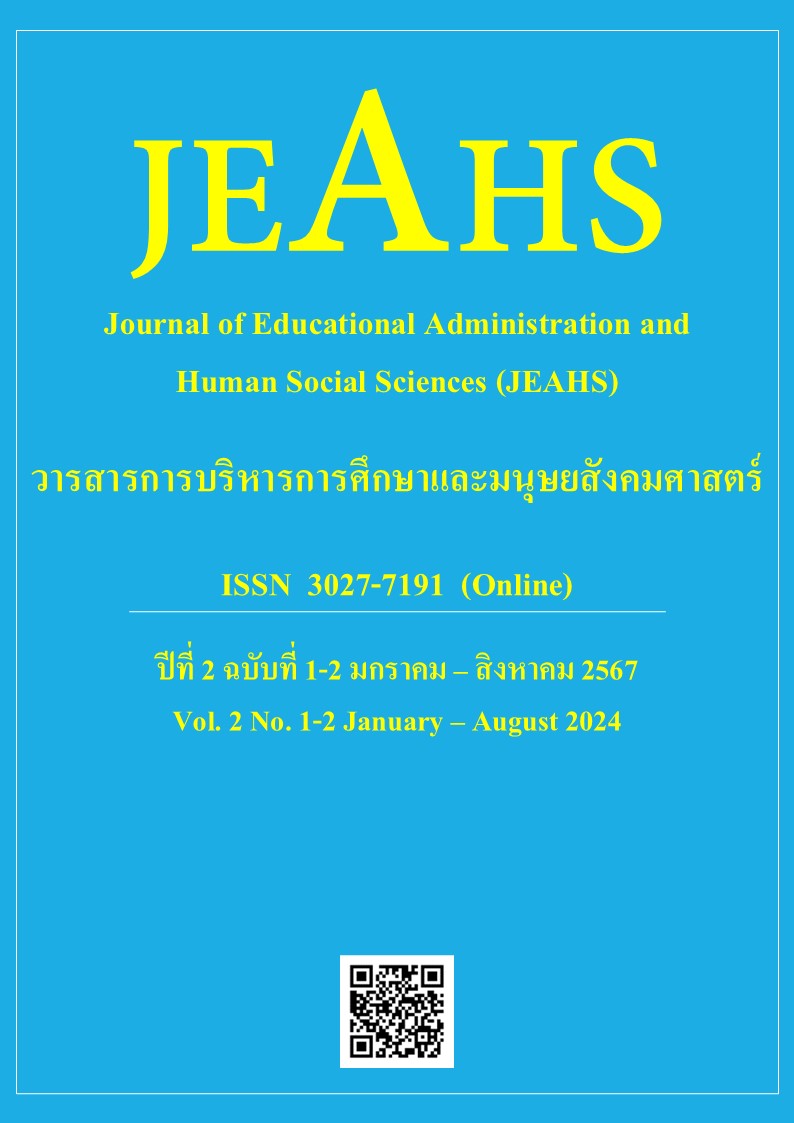THE PROCESS OF TEACHING AND LEARNING USING BUDDHIST AGRICULTURAL PRACTICES
Main Article Content
Abstract
The process of teaching and learning with Buddhist agricultural methods has important principles, emphasizing hands-on practice so that students can learn from direct experiences, develop skills, and apply knowledge to solve real-life problems. Teachers play an important role in demonstrating and training students to practice repeatedly until they gain expertise. The main objectives are: 1) Mental aspect: promoting students’ independence, good conscience, and self-reliance; 2) Social aspect: promoting cooperation and mutual assistance in the community; 3) Natural resources and environment aspect: teaching students to use and care for natural resources in a worthwhile manner; 4) Technology aspect: promoting students to apply technology to agricultural work; and 5) Economic aspect: emphasizing reducing expenses, increasing income, and sufficiency in living. In summary, teaching and learning with Buddhist agricultural methods not only teaches agricultural skills, but also focuses on developing students to be good people, have knowledge and skills, and be able to live happily, in line with the principles of sustainable development in terms of economy, society and environment.
Article Details

This work is licensed under a Creative Commons Attribution-NonCommercial-NoDerivatives 4.0 International License.
บทความที่ส่งมาขอรับการตีพิมพ์ในวารสารวารสารการบริหารการศึกษาและมนุษยสังคมศาสตร์ จะต้องไม่เคยตีพิมพ์หรืออยู่ระหว่างการพิจารณาจากผู้ทรงคุณวุฒิเพื่อตีพิมพ์ในวารสารอื่น รวมทั้งผู้เขียนจะต้องคำนึงถึงจริยธรรมการวิจัย ไม่ละเมิดหรือคัดลอกผลงานของผู้อื่นมาเป็นของตนเอง ซึ่งทางวารสารได้กำหนดความซ้ำของผลงานด้วยโปรแกรม CopyCat เว็บ Thaijo ในระดับ ไม่เกิน 25%
ในกรณีที่ บทความวิจัยมีกระบวนการวิจัยเกี่ยวข้องกับมนุษย์ ผู้นิพนธ์จะต้องส่งหลักฐานการรับรองจริยธรรมการวิจัยในมนุษย์มาประกอบการลงตีพิมพ์ด้วยจึงจะได้รับการพิจารณาลงตีพิมพ์ในวารสาร
ผู้เขียนบทความจะต้องปฏิบัติตามหลักเกณฑ์การเสนอบทความเพื่อตีพิมพ์ในวารสารการบริหารการศึกษาและมนุษยสังคมศาสตร์ รวมทั้งระบบการอ้างอิงต้องเป็นไปตามหลักเกณฑ์ของวารสารการบริหารการศึกษาและมนุษยสังคมศาสตร์ โดยรวมทั้งทัศนะและความคิดเห็นที่ปรากฏในบทความในวารสารการบริหารการศึกษาและมนุษยสังคมศาสตร์ ถือเป็นความรับผิดชอบของผู้เขียนบทความนั้น และไม่ถือเป็นทัศนะและความรับผิดชอบของกองบรรณาธิการวารสารการบริหารการศึกษาและมนุษยสังคมศาสตร์ และวารสารการบริหารการศึกษาและมนุษยสังคมศาสตร์
References
ชนะ วันหนุน. (2564). แนวความคิดในการจัดการเรียนการสอนวิชาเกษตร. แหล่งที่มา http://158.108.70.5/emagazine/ emagazine1/agriculture.html สืบค้นเมื่อ 10 ต.ค. 2564.
ทิศนา แขมมณี. (2551). 14 วิธีสอนสำหรับครูมืออาชีพ. พิมพ์ครั้งที่ 8. กรุงเทพมหานคร: โรงพิมพ์แห่งจุฬาลงกรณ์มหาวิทยาลัย.
ปภาวรา ประเสริฐ. (2564). แนวทางการจัดการเรียนการสอนแบบ Active Learning. แหล่งที่มา https://www.sesao30. go.th/ สืบค้นเมื่อ 10 ต.ค. 2564.
พระเทพรัตนมุนี (สายพงศ์อโนมปญฺโญ/กองสินธุ์). (2559). การเกษตรแนวพุทธเพื่อแก้ปัญหาเศรษฐกิจชุมชน. วารสารปัญญาปณิธาน. 1(2). 34-47.
พระเทพรัตนมุนี (สายพงศ์ อโนมปญฺโญ/กองสินธุ์), พระมหาบาง เขมานนฺโท, พระครูสุธีคัมภีรญาณ และ ประยูร แสงใส. (2557). การเกษตรแนวพุทธเพื่อแก้ปัญหาเศรษฐกิจชุมชน. วารสารช่อพะยอม. 25(1). 53-64.
พระพรหมคุณาภรณ์ (ป. อ. ปยุตฺโต). (2551). พจนานุกรมพุทธศาสตร์ฉบับประมวลธรรม. กรุงเทพมหานคร: มหาวิทยาลัยมหาจุฬาลงกรณราชวิทยาลัย.
พระพรหมบัณฑิต (ประยูร ธมฺมจิตโต). (2548). การเผยแผ่เชิงรุก. กรุงเทพมหานคร: โรงพิมพ์มหาจุฬาลงกรณราชวิทยาลัย.
สมยศ ต่ายแก้ว. (2551). การยึดผู้เรียนเป็นศูนย์กลางและการประเมินตามสภาพจริง. เชียงใหม่: โรงพิมพ์แสงศิลป์.
อาภรณ์ ใจเที่ยง. (2553). หลัการสอน. พิมพ์ครั้งที่ 5. กรุงเทพมหานคร: โอ.เอส.พริ้นติ้ง เฮ้าส์.
Hilgard E.R. & G.H Brower. (1974). Theories of Learning. 4 ed. New York: Applotoncentury.


